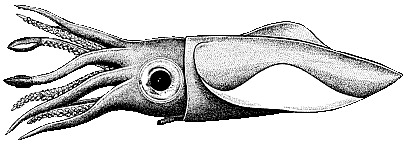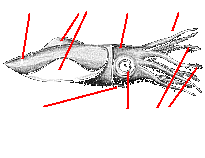The World's Biggest Flasher
Taningia danae


Total length of specimen: 2 m (7 ft)
Weight: 61 kg (134 lb)
Sex: female

 Head: houses the brain.
Head: houses the brain.
Eyes: the size of a large grapefruit.
Fins: very large in this species.
They are used mainly for swimming,
gliding, and steering.
Mantle: the main body. This
muscular sac contains most of the
organ systems.
Arms (8): lined with two rows of hooks, not suckers.
Light organs: located at the tips of two arms.
They look like black lumps. See how they work
Feeding tentacles (none): This is
one of only a few squid species
that have none as adults.
Funnel: a multipurpose tube used
in breathing, jetting, squirting
ink, laying eggs, and expelling
waste.
Learn about the most recent capture off Spain of a 275 pound Taningia danae.
Ocean Planet Exhibition Floorplan
Smithsonian Giant Squid Overview Page
gene carl feldman / gene@seawifs.gsfc.nasa.gov